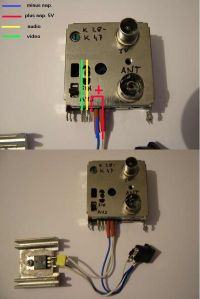Garyl
Full Member level 5
Hello.
I have a PAL signal source and I wanted to modulate it to the 30~~ Channel..
I have a VCR (Videocassette recorder) which outputs signal on 30-40 channel.
It works and generates WHITE BARS when in test mode.
I wanted to use the PAL signal modulator from VCR to modulate my PAL signal into the TV aerial output.
I have opened VCR, found the modulator, and tested that it has following pins:
1. Video
2. Audio
3. VCC 5V
4. Disconnected / ground
5. VCC 5V
And the case is GND.
I then I have made three tests:
1. I have soldered camera PAL input to VIDEO pin (and ground to ground) and turned VCR on. It worked, modulator output was the image from the camera.
2. I have turned VCR off (unplugged it) and added external 5V source to the 3 and 5 pin. It worked, modulator output was the image from the camera.
3. I have desoldered the modulator module from the VCR, connected it to 5V source and video signal and.... the camera video is black! But the test white bars are working. WHY??
4. I have soldered back the modulator to VCR to see if I damaged it, but no - it works perfectly in VCR in the configurations from points 1 and 2.
This is the reference image (but not mine, altough my modulator is very similiar):

My question is: What am I missing? Why this modulator is not modulating my video signal when outside the VCR (but it's correctly generating test white bars)?
I have a PAL signal source and I wanted to modulate it to the 30~~ Channel..
I have a VCR (Videocassette recorder) which outputs signal on 30-40 channel.
It works and generates WHITE BARS when in test mode.
I wanted to use the PAL signal modulator from VCR to modulate my PAL signal into the TV aerial output.
I have opened VCR, found the modulator, and tested that it has following pins:
1. Video
2. Audio
3. VCC 5V
4. Disconnected / ground
5. VCC 5V
And the case is GND.
I then I have made three tests:
1. I have soldered camera PAL input to VIDEO pin (and ground to ground) and turned VCR on. It worked, modulator output was the image from the camera.
2. I have turned VCR off (unplugged it) and added external 5V source to the 3 and 5 pin. It worked, modulator output was the image from the camera.
3. I have desoldered the modulator module from the VCR, connected it to 5V source and video signal and.... the camera video is black! But the test white bars are working. WHY??
4. I have soldered back the modulator to VCR to see if I damaged it, but no - it works perfectly in VCR in the configurations from points 1 and 2.
This is the reference image (but not mine, altough my modulator is very similiar):

My question is: What am I missing? Why this modulator is not modulating my video signal when outside the VCR (but it's correctly generating test white bars)?